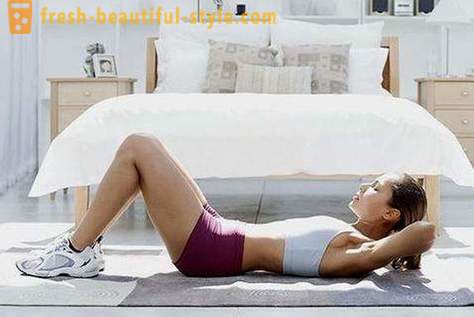Pilates at home: a basic package and the basic tenets of direction

One of the complexes that can have an impact not only on your figure, but also on the general state of health is Pilates. This is a fairly new trend, if we compare it with techniques such as yoga or tai chi. The time of the birth of Pilates is 20 years of the last century. Then this technique had one, a well-defined goal - rehabilitation of soldiers after the war. It was developed by Joseph Pilates and is still relevant. Not so long ago in Russia and came to Pilates. Moscow was the first city to experience this system for yourself. Today, this trend is becoming more popular.
What is Pilates?
Pilates - a set of exercises, aimed primarily at the development of the muscular system. This group included abdominal muscles, back muscles and intercostal muscles. Pursue this kind of training can be both under the supervision of a coach, and at home. Pilates at home - this is a unique opportunity to get a beautiful and slender body, not leaving home and without exhausting yourself many days of training. In another such technique is called conscious training system. Its advantage is that it allows using a minimum of physical activity to achieve brilliant results.
Pilates at home: the basic principles of this complex
The founder of the development of his ideas laid the foundations that violate undesirable. Otherwise defeats the purpose to carry out such exercises in general. Pilates basic postulates are as follows:
- Breathing. A special system in which the main work is done by the lower part of the lungs and abdomen and thorax are subsidiary bodies.
- concentration. This item includes the exercises are not mechanically but consciously.

- Centers. Another condition, if you choose Pilates at home. However, it is important for fitness centers. Centering comprises stabilizing housing. It is necessary to create a special belt force in the formation of which involves the abdominal muscles.
- The smoothness and precision. This postulate is understandable to anyone. Its main condition - to avoid sudden movements.
- Alignment. Pilates at home allows you to align the muscle balance, make your body proportionate.
- Relaxation. Performing exercises on a specific muscle group, it is desirable not to strain the other. They should be relaxed.
- Endurance. Pilates at home will allow you to increase your body's endurance, almost without putting this much effort.
- The regularity. Perform these exercises should be at least 3 times a week.
The main unit of the Pilates exercise technique
The backbone of all directions are 5 exercises that are available even to those people whose physical condition leaves something to be desired.
- The rise of the pelvis. The feet should be tightened at the knees, the feet are not recommended to tear off the floor. To raise the pelvis, while breathing air to remain in this position for a few seconds and to return to its original position.

- The pose of the embryo. The essence of the exercise is to squat slowly to his feet. In this starting position - kneeling. During the process, it is necessary to follow the breath.
- Kicks. Initial position - lying on his stomach. Raise the rear part of the body, pull arm in the direction that the body resembles the letter T. Perform heels strikes against each other for several seconds.
- Pendulum. Lying on his side to perform foot moves. Repeat the exercise with the other hand. It is recommended to do 10 swings.
- Breathing. Exercise performed lying on your back. While breathing, you should involve the stomach. On the exhale - relax it.
Pilates at home - a good alternative to many hours of painstaking training in the gym. Having mastered the basic complex, you will notice the results immediately. More complex exercises will help to further stretch and strengthen your muscles.













































